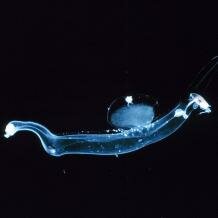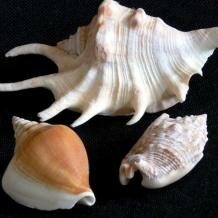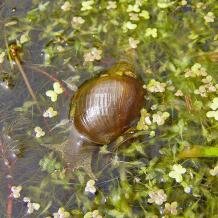Topic: Camera eyes in gastropod molluscs
The fast-moving cephalopod molluscs are famous for their camera eyes, but why on earth have gastropod snails, which are not exactly known for their speed, evolved this superb visual organ at least four times?
The independent evolution of a camera eye in cephalopod molluscs and vertebrates is one of the best-known examples of convergence, but many other molluscs (which include bivalves and snails) have eyes. Not surprisingly, these come in a variety of forms. One interesting convergence, involving the cephalopod nautiluses (Nautilus) and the bivalve giant clams (Tridacna), is the independent acquisition of a pinhole eye. In passing, it should be mentioned that amongst the most fascinating of eyes in other molluscs are the reflector eyes of scallops such as Pecten. Here, the inside of the eye is lined with mirrors, which reflect the image such that it is focussed on a central point. Similar arrangements are found in crustaceans, as well as the spookfish (Dolichopteryx longipes). In this fish, however, the eye is split with another part containing a lens, thus using a remarkable combination of optics based on both refraction and reflection.
In the context of the evolution of camera eyes, it is very significant that even within the molluscs this design has evolved independently in the cephalopods and at least four times within the gastropod snails (which might be a little unexpected, as the need for well-developed eyes in these usually slow-moving creatures is not immediately obvious). Hence, we find camera eyes in the pelagic heteropods (Pterotracheoidea) and a variety of bottom-dwelling snails that include the true conchs (Strombidae), the pulmonates (Pulmonata), the periwinkles (Littorinidae) and also other prosobranch snails such as the freshwater Viviparus.
Heteropod scanning camera eyes
 The heteropods are a particularly interesting group of active carnivores that swim in the water column and typically have a reduced shell and a body that is largely transparent (another example of convergence). Their large camera eyes probably possess vertebrate-like acuity, but they are distinctive, not least because the retina is not cup-shaped but takes the form of a narrow ribbon (straight or U-shaped). Whilst this would imply that the animal is seeing the world through little more than a slit, in point of fact the eye is quickly rotated to provide a scanning motion. This is strikingly convergent, having evolved independently in such groups as the jumping spiders (Salticidae) and the larvae of diving beetles (Dytiscidae).
The heteropods are a particularly interesting group of active carnivores that swim in the water column and typically have a reduced shell and a body that is largely transparent (another example of convergence). Their large camera eyes probably possess vertebrate-like acuity, but they are distinctive, not least because the retina is not cup-shaped but takes the form of a narrow ribbon (straight or U-shaped). Whilst this would imply that the animal is seeing the world through little more than a slit, in point of fact the eye is quickly rotated to provide a scanning motion. This is strikingly convergent, having evolved independently in such groups as the jumping spiders (Salticidae) and the larvae of diving beetles (Dytiscidae).
Strombid camera eyes
 The true conchs are a large and successful group of tropical snails, and it is evident that their camera eyes have considerable sophistication and remarkable acuity. It is, however, not immediately clear why these dozy herbivores need such splendidly designed eyes. The answer is that strombidls are not only able to detect predators (many of which are other snails, such as the venomous cone shells), but also have an extraordinary escape reaction. They can travel up to 30 cm in a series of jumps, propelling themselves upwards with their foot and so to safety. The eyes may well see danger and also play a role in their ballet of escape.
The true conchs are a large and successful group of tropical snails, and it is evident that their camera eyes have considerable sophistication and remarkable acuity. It is, however, not immediately clear why these dozy herbivores need such splendidly designed eyes. The answer is that strombidls are not only able to detect predators (many of which are other snails, such as the venomous cone shells), but also have an extraordinary escape reaction. They can travel up to 30 cm in a series of jumps, propelling themselves upwards with their foot and so to safety. The eyes may well see danger and also play a role in their ballet of escape.
Pulmonate camera eyes
 Pulmonates are air-breathing snails that occupy mainly terrestrial but also freshwater and marine habitats (where they regularly come to the water surface to breathe). The camera eyes of aquatic and terrestrial species differ in several respects. While the retinas of terrestrial pulmonates are conventional and cup-shaped, those of aquatic species are partitioned into pits separated by a ridge. They furthermore differ in photopigment composition, which is likely to reflect the light conditions in the snails’ habitats. The eyes of two species that regularly seek refuge from predators above the water surface (great pond snail Lymnaea stagnalis and wandering snail Radix peregra) function in air as well as in water. Generally, the eyes of aquatic species appear to be superior in terms of resolution. This has been linked to these snails’ need to locate vertical stems, which they climb to reach the surface for breathing.
Pulmonates are air-breathing snails that occupy mainly terrestrial but also freshwater and marine habitats (where they regularly come to the water surface to breathe). The camera eyes of aquatic and terrestrial species differ in several respects. While the retinas of terrestrial pulmonates are conventional and cup-shaped, those of aquatic species are partitioned into pits separated by a ridge. They furthermore differ in photopigment composition, which is likely to reflect the light conditions in the snails’ habitats. The eyes of two species that regularly seek refuge from predators above the water surface (great pond snail Lymnaea stagnalis and wandering snail Radix peregra) function in air as well as in water. Generally, the eyes of aquatic species appear to be superior in terms of resolution. This has been linked to these snails’ need to locate vertical stems, which they climb to reach the surface for breathing.
Littorinid camera eyes
 The camera eyes of littorinids, which inhabit seashores and the intertidal zone, also clearly provide considerable visual powers. It seems that the eyes of some species (e.g. common periwinkle Littorina littorea) are constructed for vision under water, while those of others that are primarily active above the water surface (e.g. marsh periwinkle L. irrorata) perform better in air. At least in some cases, the demand for visual acuity might have arisen because on tidal flats these gastropods must climb up the stalks of vegetation to escape such predators as crabs when the tide comes in.
The camera eyes of littorinids, which inhabit seashores and the intertidal zone, also clearly provide considerable visual powers. It seems that the eyes of some species (e.g. common periwinkle Littorina littorea) are constructed for vision under water, while those of others that are primarily active above the water surface (e.g. marsh periwinkle L. irrorata) perform better in air. At least in some cases, the demand for visual acuity might have arisen because on tidal flats these gastropods must climb up the stalks of vegetation to escape such predators as crabs when the tide comes in.
Cite this web page
Map of Life - "Camera eyes in gastropod molluscs"
https://mapoflife.org/topics/topic_282_camera-eyes-in-gastropod-molluscs/
April 28, 2021

